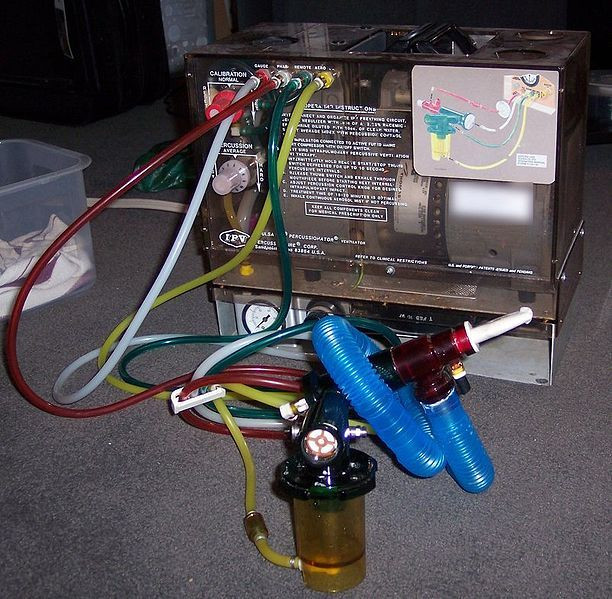Listening To Music May Reduce Anxiety And Medication For Hospital Patients Using Ventilators

Among intensive care unit (ICU) patients receiving acute ventilatory support, listening to music results in a reduction of anxiety as well as sedation frequency and intensity compared to usual care, according to a recent study.
Today, the vast majority of critically ill patients who receive mechanical ventilation - even those with acute lung injury or acute respiratory distress syndrome - survive. To reduce anxiety and promote comfort and ventilator synchrony, critically ill and mechanically ventilated patients receive intravenous sedative and analgesic medications.
These potent medications are often administered at high doses for prolonged periods and are associated with adverse effects, such as bradycardia, hypotension, gut dysmotility, immobility, weakness, and delirium. Despite protocols and sedation assessment tools that guide clinicians, patients still experience significant levels of anxiety. Not only are unrelieved anxiety and fear unpleasant symptoms, but increased sympathetic nervous system activity can cause dyspnea and increased myocardial oxygen demand. It would be significant to discover nonpharmacological interventions that would be effective in calming anxiety while reducing medication administration.
Musical Intervention
Linda L. Chlan, Ph.D., R.N., of Ohio State University, and colleagues conducted a study to evaluate if a patient-directed music (PDM) therapy could reduce anxiety and sedative exposure in ICU patients on mechanical ventilation.
The clinical trial included 373 patients from 12 ICUs at five hospitals in the Minneapolis-St. Paul area; all received acute mechanical ventilatory support for respiratory failure between September 2006 and March 2011. Of the patients included in the study, the average age was 59 years. Patients were divided into three groups. In one group, 126 patients initiated PDM (with preferred selections tailored by a music therapist) whenever they desired. In a second group, 122 patients initiated the use of noise-canceling headphones (NCH) whenever they desired. In the final group, 125 patients received the usual care.
The researchers examined daily assessments of anxiety on a 100-mm visual analog scale (VAS) from "not anxious at all" to "most anxious ever" as well as two aggregate measures of sedative exposure (intensity and frequency).
The PDM patients listened to music for an average of 80 minutes per day; the NCH patients wore the noise-abating headphones for an average of 34 minutes per day.
Results of the study showed patients in the PDM group had an anxiety score that was 19.5 points lower than patients in the usual care group. On the fifth day (the average time patients were enrolled), a usual care patient received five doses of sedative medication while an equivalent PDM patient received only three doses - a relative reduction of 38 percent. By the end of the fifth day, a PDM patient had a relative reduction of 36 percent in their sedation intensity score and 36.5 percent in their anxiety score.
Yet, PDM did not result in greater reduction in anxiety or sedation intensity compared to NCH.
"[Music] is an inexpensive, easily implemented non-pharmacological intervention that can reduce anxiety, reduce sedative medication exposure, and potentially associated adverse effects," wrote the authors.
Critique
In an accompanying editorial, Elie Azoulay, M.D., Ph.D., of the Universite Paris-Diderot, Sorbonne Paris-Cite, and colleagues commented on the findings of this study. "An increasing number of studies over the past decade have focused not only on survival, but also on the patients' experience of critical care," wrote Azoulay.
Such studies have evaluated three periods: the intensive care unit (ICU) stay and experiences of confusion, delirium, acute stress, nightmares, hallucinations, and sleep disorders; the first few weeks or months after ICU discharge and symptoms of posttraumatic stress disorder (PTSD), cognitive impairment, and depression; and the period beyond one year after ICU discharge. Many of these studies have shown a relationship between the amount of ICU sedation and decline in factual memory, presence of delusional memory, and additional PTSD-related symptoms.
One study with an eight-year follow-up found acute stress at ICU discharge in 44 percent of patients and PTSD during follow-up in 24 percent. In another study that evaluated in-ICU symptoms recalled by patients several weeks to months after ICU discharge, anxiety was reported by 52 percent of patients. Although the study by Chlan and associates demonstrates that an apparently easily-implemented intervention used actively by the patient can reduce anxiety, several issues remain.
First, it is not clear whether anxiety really was the primary end point of the study. In the study, patients used a VAS to self-report their level of anxiety in response to the question "How are you feeling today?" The VAS score collected in the study probably reflected satisfaction or general well-being, as well as anxiety. Second, only short-term outcomes were evaluated. Third, the study included patients who were both conscious and receiving mechanical ventilation. Whether providing music to more deeply sedated patients can decrease sedation plus delirium and post-ICU burden deserves investigation. Fourth, sedative administration was not standardized across ICUs. And finally, the study report does not describe the ICU environment in terms of patient-centered and holistic care; information on the involvement of relatives in the choice of music, for instance, would be of interest.
"Reducing anxiety and amount of sedation in mechanically ventilated patients is of the utmost importance, particularly because the result may be a decrease in the post-ICU burden, which weighs heavily on many patients, as well as numerous complications related to sedation," wrote Azoulay. "The trial by Chlan et al provides preliminary data that create new possibilities for improving the well-being of ICU patients. Further studies are needed to better understand how music therapy might improve the ICU experience for critically ill patients."
Sources: Chlan LL, Weinert CL, Heiderscheit A, Tracy MF, Skaar DJ, Guttormson JL, Savik K. Effects of Patient-Directed Music Intervention on Anxiety and Sedative Exposure in Critically Ill Patients Receiving Mechanical Ventilatory Support: A Randomized Clinical Trial. JAMA. 2013.
Azoulay E, Chaize M, Kentish-Barnes N. Music Therapy for Reducing Anxiety in Critically Ill Patients. JAMA. 2013
Published by Medicaldaily.com



























